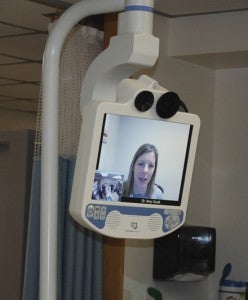Vidant Beaufort debuts robot technology for stroke victims
Published 8:05 pm Friday, January 15, 2016

CAROLINE HUDSON | DAILY NEWS
SAVING LIVES: Vidant Beaufort nursing assistant Evalyn Harding plays the role of patient during Thursday’s demonstration, as Dr. Amy Guzik assesses her with the stroke scale.
Vidant Beaufort Hospital continues to update its technology and recently debuted top-of-the-line equipment for stroke patients.
Called “Telestroke,” the new equipment is a portable, robotic system connected to Wi-Fi so doctors can video call into the hospital from anywhere in the world to assess a potential stroke victim. Doctors can also send vitals and symptoms to review a patient’s status as quickly as possible.
On Thursday, Vidant employees and representatives from InTouch Health and medical company Genentech participated in a demonstration of how the equipment works. Using the video call, doctors in Washington now have access to direct recommendations from six stroke neurologists at Wake Forest Baptist Medical Center in Winston-Salem.
Dr. Amy Guzik from the Medical Center participated in Thursday’s demonstration.

CAROLINE HUDSON | DAILY NEWS
EXPERT ADVICE: Dr. Amy Guzik, a stroke neurologist at Wake Forest Baptist Medical Center, calls in via the Telestroke machine. Vidant Beaufort doctors will now have direct access to six stroke neurologists at Wake Forest from anywhere in the world.
The stroke neurologists can review a patient’s symptoms, talk via video with the patient or doctor and run through the stroke scale with the patient.
A stroke scale is a quick guideline to assess the severity of a stroke, using 11 criteria, such as level of consciousness, motor skills in arms and legs and speech.
Once the neurologist assesses the patient, he or she can recommend the clot-busting drug Activase (formerly TPA) for treatment — all of this within a matter of minutes.
Kim Skodack, region account manager with InTouch Health, said there is a 4.5-hour time frame in which a patient can receive the clot-busting treatment, which is why it is important to call 911 instead of waiting.
“The No. 1 reason that patients aren’t treated with the clot-busting drug is that they don’t arrive to the hospital (in time),” she said, adding that a patient’s chances of recovery go up “the sooner they get here and the sooner they call 911.”
There are three ways to identify a potential stroke: facial paralysis (an uneven smile), weakness in one arm and slurred speech, according to Genentech, which makes and distributes Activase.
After passing the 4.5-hour time frame, Skodack said treatment then moves to retrieving the clot by threading a catheter to the brain.
The neurologists at Wake Forest Medical Center also specialize in stroke care, which is an added benefit, because without the Telestroke, standard protocol would be to call Vidant Medical Center in Greenville and try to speak with a general neurologist, according to Lou Montana-Rhodes, RN, MSN.
“A patient can get immediate care here,” Skodack said. “If they’re closer to here, they don’t need to be going to Greenville.”
Pam Shadle, manager of marketing and public relations at Vidant Beaufort, said the sister hospitals Vidant Edgecombe and Vidant Duplin have the new equipment, as well.
She said the staff at Vidant Beaufort is entering name suggestions into a drawing to name the Telestroke robot. They are glad to have the new technology, as they can now provide better, more immediate care to patients, according to Shadle.
“I think this shows our commitment to the community,” Montana-Rhodes said.





